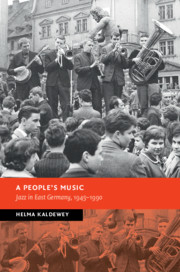Book contents
- A People’s Music
- New Studies in European History
- A People’s Music
- Copyright page
- Contents
- Figures
- Preface
- Chronology
- Abbreviations
- Chapter 1 Jazz in Weimar and Nazi Germany, 1918–1945
- Chapter 2 Jazz in the Soviet Zone, 1945–1949
- Chapter 3 Jazz in the Founding Years of the GDR, 1949–1961
- Chapter 4 Jazz Behind the Wall, 1961–1971
- Chapter 5 The Rise of New Jazz, 1971–1979
- Chapter 6 “A National Treasure”: Jazz Made in the GDR, 1980–1990
- Archival Sources
- Appendix
- Bibliography
- Index
Chapter 3 - Jazz in the Founding Years of the GDR, 1949–1961
Published online by Cambridge University Press: 02 December 2019
- A People’s Music
- New Studies in European History
- A People’s Music
- Copyright page
- Contents
- Figures
- Preface
- Chronology
- Abbreviations
- Chapter 1 Jazz in Weimar and Nazi Germany, 1918–1945
- Chapter 2 Jazz in the Soviet Zone, 1945–1949
- Chapter 3 Jazz in the Founding Years of the GDR, 1949–1961
- Chapter 4 Jazz Behind the Wall, 1961–1971
- Chapter 5 The Rise of New Jazz, 1971–1979
- Chapter 6 “A National Treasure”: Jazz Made in the GDR, 1980–1990
- Archival Sources
- Appendix
- Bibliography
- Index
Summary
examines the period from 1949-1961, the first decade of the GDR. The chapter explores Marxist perceptions of jazz from both sides of the Atlantic that informed socialist-realist doctrine, contextualizing these views in the years before and after Joseph Stalin’s death. During this a newly-formed State Commission for the Arts (STAKOKU) sought to shield German cultural values against supposed American cultural decadence, restrictions that contributed to widespread dissent that peaked in a broader uprising in 1953. Analyzing the East German musical discourse of the 1950s that sought to rehabilitate jazz, this chapter explores its links to the 19th-century tradition of Hausmusik, including the prolific West Berlin jazz scene that sought to attract fans from East Berlin and beyond. Critically, at this time the STASI initiated its surveillance of the jazz scene, recruiting secret informants that proved pivotal in shaping East German jazz life. Ultimately, galvanized by political pressures and rising defections to the West throughout the 1950s, East German leadership responded by building the Berlin Wall. Dividing the city and country sorely impacted the spread of jazz activities, and resulted in the formation of a jazz scene specific to the GDR.
Keywords
- Type
- Chapter
- Information
- A People's MusicJazz in East Germany, 1945–1990, pp. 75 - 142Publisher: Cambridge University PressPrint publication year: 2019

